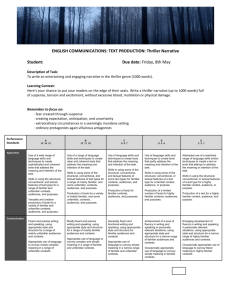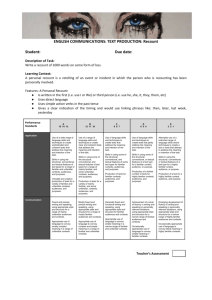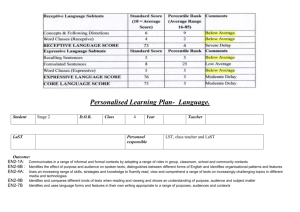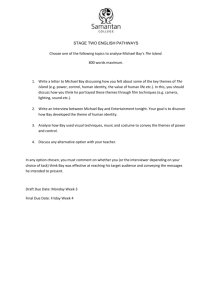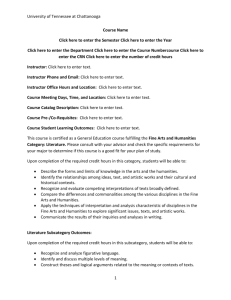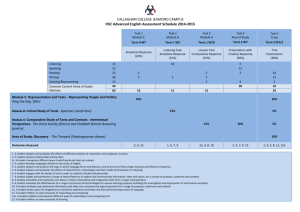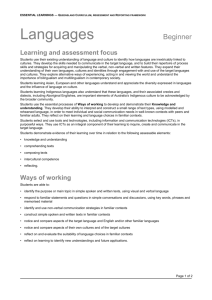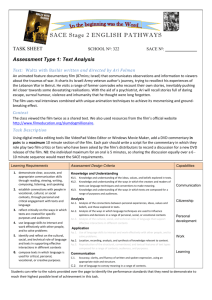File
advertisement
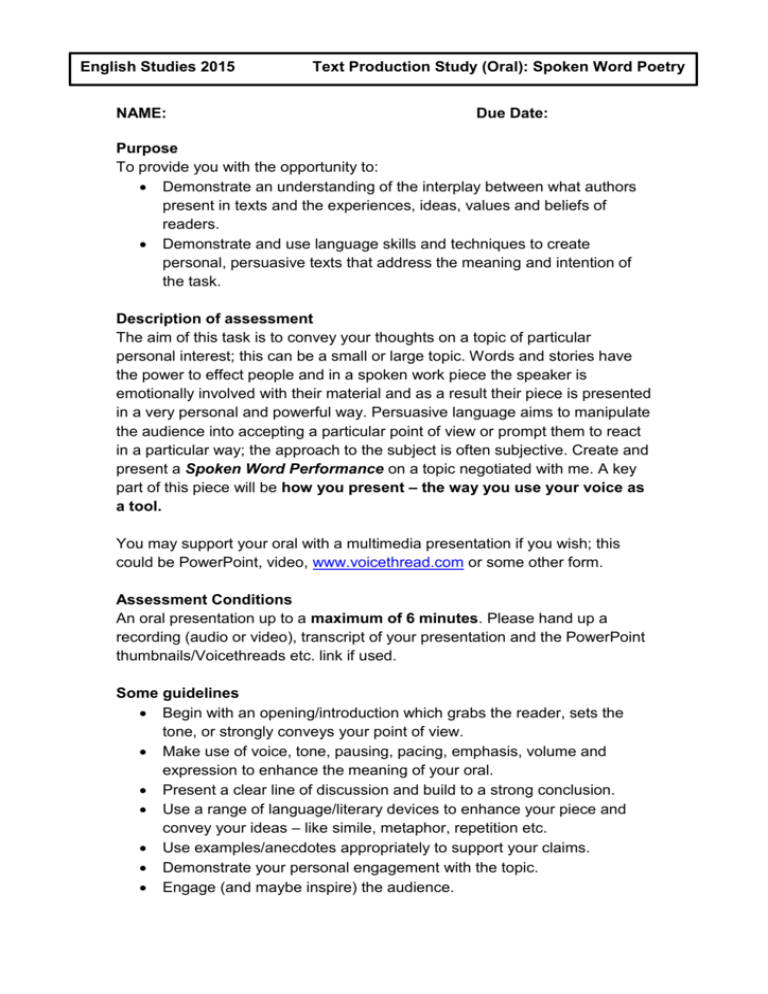
English Studies 2015 NAME: Text Production Study (Oral): Spoken Word Poetry Due Date: Purpose To provide you with the opportunity to: Demonstrate an understanding of the interplay between what authors present in texts and the experiences, ideas, values and beliefs of readers. Demonstrate and use language skills and techniques to create personal, persuasive texts that address the meaning and intention of the task. Description of assessment The aim of this task is to convey your thoughts on a topic of particular personal interest; this can be a small or large topic. Words and stories have the power to effect people and in a spoken work piece the speaker is emotionally involved with their material and as a result their piece is presented in a very personal and powerful way. Persuasive language aims to manipulate the audience into accepting a particular point of view or prompt them to react in a particular way; the approach to the subject is often subjective. Create and present a Spoken Word Performance on a topic negotiated with me. A key part of this piece will be how you present – the way you use your voice as a tool. You may support your oral with a multimedia presentation if you wish; this could be PowerPoint, video, www.voicethread.com or some other form. Assessment Conditions An oral presentation up to a maximum of 6 minutes. Please hand up a recording (audio or video), transcript of your presentation and the PowerPoint thumbnails/Voicethreads etc. link if used. Some guidelines Begin with an opening/introduction which grabs the reader, sets the tone, or strongly conveys your point of view. Make use of voice, tone, pausing, pacing, emphasis, volume and expression to enhance the meaning of your oral. Present a clear line of discussion and build to a strong conclusion. Use a range of language/literary devices to enhance your piece and convey your ideas – like simile, metaphor, repetition etc. Use examples/anecdotes appropriately to support your claims. Demonstrate your personal engagement with the topic. Engage (and maybe inspire) the audience. Assessment Design Criteria Knowledge and Understanding The specific features are as follows: KU2 Knowledge and understanding of ideas, values, and beliefs in texts. Application The specific features are as follows: Ap1 Use of language skills and techniques to create coherent texts that address the meaning and intention of the task. Ap4 Use of textual, structural, and conventional features of selected text types and forms of presentation to convey meaning. Communication The specific features are as follows: C1 Accuracy, clarity, and fluency of expression. C2 Appropriate form and register for audience and purpose. Performance Standards - Knowledge and Understanding Application Communication A KU2: Detailed knowledge and understanding of the ideas, values, and beliefs in familiar and unfamiliar texts. Ap1: Use of a wide range of language skills and techniques to create sophisticated and coherent texts that address the meaning and intention of the task. C1: Fluent and precise writing and speaking, using appropriate style and structure for a range of mainly unfamiliar audiences and contexts. Ap4: Skills in using the textual, structural, and conventional features of text types for a range of familiar and unfamiliar contexts, audiences, and purposes. C2: Appropriate use of form and register to convey mostly complex meaning in a range of unfamiliar contexts. Performance Standards - Knowledge and Understanding Application Communication A KU2: Detailed knowledge and understanding of the ideas, values, and beliefs in familiar and unfamiliar texts. Ap1: Use of a wide range of language skills and techniques to create sophisticated and coherent texts that address the meaning and intention of the task. C1: Fluent and precise writing and speaking, using appropriate style and structure for a range of mainly unfamiliar audiences and contexts. Ap4: Skills in using the textual, structural, and conventional features of text types for a range of familiar and unfamiliar contexts, audiences, and purposes. C2: Appropriate use of form and register to convey mostly complex meaning in a range of unfamiliar contexts. Ap1: Use of a range of language skills and techniques to create clear and coherent texts that address the meaning and intention of the task. C1: Mostly fluent and precise writing and speaking, using appropriate style and structure for a range of mostly familiar audiences and contexts. B KU2: Knowledge and understanding of some ideas, values, and beliefs in familiar, and some unfamiliar, texts. Ap4: Skills in using some of the textual, structural, and conventional features of text types for a range of mainly familiar, and some unfamiliar, contexts, audiences, and purposes. C D KU2: Knowledge and understanding of some ideas, values, and beliefs in mainly familiar texts. KU2: Knowledge and understanding of some familiar ideas, values, and beliefs in familiar texts. Ap1: Use of language skills and techniques to create texts that address the meaning and intention of the task. C1: Generally fluent and functional writing and speaking, using appropriate style and structure for familiar audiences and contexts. Ap4: Skills in using some of the textual, structural, and conventional features of some text types for familiar contexts, audiences, and purposes. C2: Appropriate use of form and register to convey simple meaning in a narrow range of familiar and unfamiliar contexts. Ap1: Use of some language skills and techniques to create texts that partly address the meaning and intention of the task. C1: Achievement of a level of fluency in writing and speaking, in a mainly appropriate style. Ap4: Skills in using some of the textual, structural, or conventional features of a text type for a familiar context, audience, or purpose. E KU2: Identification of an idea, a value, or a belief in familiar texts. C2: Appropriate use of form and register to convey complex and simple meaning in a range of familiar and unfamiliar contexts. Ap1: Attempted use of a restricted range of language skills and/or techniques to create a text or texts that attempt to address the meaning or intention of the task. Ap4: Skills in using the textual, structural, or conventional features of a text type for a highly familiar context, audience, or purpose. C2: Occasionally appropriate use of form and/or register to convey simple meaning in familiar contexts. C1: Emerging development of fluency in an occasionally appropriate style. C2: Occasionally appropriate use of form and register to convey literal meaning in highly familiar contexts.
